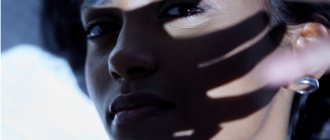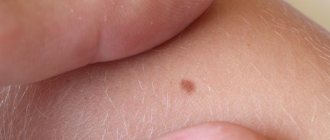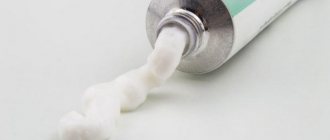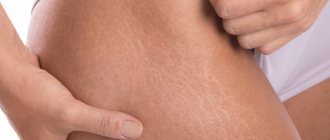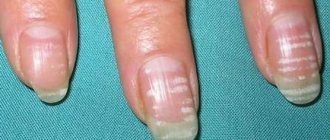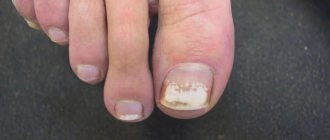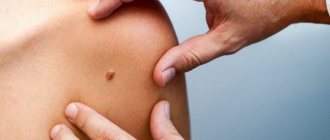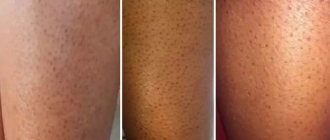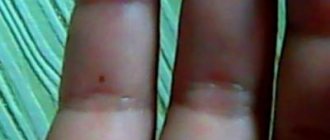Healthy nails appear pink in color, with a smooth, smooth surface and a slight natural shine. If they don't look right, this indicates a problem within the body or directly with the nails.
Changes in the color of the plate are called dyschromia in medicine. The color is distorted throughout the plate or in individual areas. Dyschromia of nails in the form of spots of white, red, yellow, blue, brown or black is more common. The reasons for their appearance are diseases of the liver, kidneys or heart, the influence of external factors, infections, and deterioration in the nutrition of the nail apparatus. Let's look at them in more detail depending on the color.
White
White spots or leukonychia are the most common type of dyschromia; they are usually not dangerous to health and are regarded as a temporary cosmetic defect. At least once in their lives, adults and children had white spots on their nails.
Why are they formed? Essentially, these are air bubbles trapped between the bed and the nail plate. At the site of the bubble, the nail retreats from the vascular skin, and a white spot appears on a pink background.
Leukonychia occurs in the form of dots, transverse stripes or wide spots.
The list of causes that causes it includes:
- Allergy to nail polish, hardener, remover or other manicure products;
- Fungal infection, white superficial onychomycosis. Initially, small white dots are visible, then the infection spreads to the entire plate. Nails peel, thicken, crumble;
- Injuries to the plate or nail matrix. Impacts, pinching, injuries during manicure or pedicure, wearing artificial surfaces;
- Lack of protein, zinc, calcium, iron in the body due to an unbalanced diet or metabolic disorders;
- Tight shoes. This is the reason why white spots appear on the toenails;
- Taking certain antimicrobial medications or treatment with chemotherapy drugs;
- Heavy metal poisoning.
It is not always possible to determine the exact reason why white spots appear on the nails of the fingers or toes. To do this, it is better to contact specialists.
If the stain is only on one finger, then most likely the cause is injury. As the plate grows, it will move to the free edge and leave along with the cut part of it.
If there are a lot of spots, you need to go to the doctor, because it is a matter of systemic disorders. When poisoned or taking medications, leukonychia appears as long light transverse stripes. With onychomycosis, the boundaries of the spots are unclear.
The doctor will examine your fingers and prescribe additional tests. In case of a systemic disorder, the underlying disease is treated. If leukonychia is caused by side effects of medications, the doctor will recommend an alternative. For onychomycosis, the affected area is cleaned, and then fungicidal ointments or creams are applied daily. In case of nutrient deficiency, vitamin and mineral complexes are prescribed.
Treatment options
To prevent complications and side effects, spots should be treated immediately after they appear. However, you first need to find out the reason for their formation, because this may be the end of treatment (if the causative agent is an external factor).
It is difficult to independently identify the problem if it is not associated with mechanical damage. To do this, you need to contact one of the doctors:
- Surgeon.
- Dermatologist.
- Pathologist.
- Mycologist (if the spots appeared due to fungus).
Most often, girls first consult with a surgeon, take the prescribed tests, and then the specialist redirects them to a more specialized doctor, who makes a diagnosis and prescribes a treatment regimen for the spots.
The longer you take to start treatment, the greater the risk of side effects. This is especially dangerous in the presence of pathologies in the body associated with organ dysfunction and disruption of systems.
The first thing to do to neutralize stains is to eliminate the cause of their appearance. This is especially easy to do when they are formed due to external factors.
For internal problems, the doctor prescribes treatment:
- If the cause of the spots is a fungus or bacterial infection, antifungal drugs are prescribed based on the stage and form of infection (active form - external drugs, advanced form - oral agents). There are quite a lot of antimycotics: Exoderil, Mikoderil, Mikozan, Lamisil;
- If there are problems with the functioning of organs and systems in a girl’s body, appropriate medications are prescribed;
- In case of circulatory problems, the doctor’s task is to get rid of blood clots and blood clots by cleansing the blood. For this, medications are prescribed: Mexidol, Tanakan, Glycine, Trental;
- To increase local immunity, doctors recommend using external anti-inflammatory ointments such as Bepanten and Panthenol. They will reduce tissue inflammation and nail destruction, accelerating the healing of the plate;
- Intoxication of the body with strong antibiotics and drugs; cleaning is necessary to eliminate the damage. For this purpose, Activated carbon, Enterosgel and other compounds that remove toxins are usually prescribed.
Sometimes spots, regardless of the reason for their formation, can cause pain to a girl, especially if they are on her legs, since discomfort is felt while walking. Then painkillers are prescribed, for example, Nise or Ibuprofen.
In case of mechanical damage to the nails or their injury during treatment of the nail bed, no special treatment instructions are prescribed. A woman only needs to take care of her hands during the recovery period, preventing the progression of spots.
At first, it is recommended to put a soft bandage on your finger to prevent pressure on it when doing household work. This will speed up healing.
To increase the likelihood of obtaining a positive outcome, attention should be paid to comprehensive treatment of the defect. For this, in addition to drug treatment, it is recommended to use folk recipes that will help increase local immunity by accelerating metabolism in the epidermis. Your doctor may prescribe specific methods for this, or you can choose them yourself.
Folk remedies
The main advantage of folk recipes is their absolute safety and effectiveness, which is associated with the use of natural ingredients that cannot cause relapse.
The main recommendation for using homemade solutions to remove stains is the frequency of their application. If you take long breaks between using methods and rarely alternate them, the effectiveness decreases sharply, so you need to use at least one method of nail restoration every day.
Several recipes are most often used against stains:
- Treating the nail bed with iodine or lemon juice. To restore the surface microflora and its acid balance, it is recommended to use one of the components for daily wiping of the nail before bed.
- Salt bath. To ensure that applied medications are better absorbed, it is worth steaming the sensitive epidermis. To do this, pour 1 tablespoon of sea salt into 1 liter of water or a decoction of medicinal herbs; additionally add a few drops of essential oil to the solution. You need to take a bath for 25 minutes.
- Compress with onions. 20 grams of aloe juice, onion pulp and lemon juice should be mixed until smooth and applied to folded gauze. Apply a compress to the nail and fix it with an adhesive bandage for half an hour.
- Lotions with laundry soap. To do this, grate 50 grams of soap on a coarse grater and mix with 9-10 drops of essential oil. The mixture is distributed over the nail and washed off after 15 minutes.
- Parsley decoction. As a replacement for regular steam baths, you can make a decoction of parsley with the addition of salt. The plant has strong antibacterial properties, so you can alternate the recipe with salt baths.
Caring for sensitive hand skin is important, so when using regular creams or applying cuticle oil, it is recommended to give a small massage to the damaged area. This will speed up blood circulation and increase tissue metabolism.
Typically, in order to completely restore a natural manicure, a girl needs to follow the prescribed recommendations and treatment regimen for two or three months, after which a new, healthy plate grows, and the stains are eliminated. However, if there is an infection on the surface, recovery lasts up to six months.
Reds
Red spots are one of the symptoms of disease or the result of the harmful influence of external factors.
Such changes cause:
- Infective endocarditis or bacterial damage to the heart valves. During the disease, microthrombi form, which clog the capillaries in the area of the nail plate. Infective endocarditis appears as small red streaks, dots that resemble splinters;
- Injuries that lead to local hemorrhage;
- Psoriasis. This is an autoimmune pathology. Sometimes it manifests itself in the form of subungual hemorrhages, forming dark red spots;
- Contact with aggressive household chemicals without protective gloves.
If there have been no injuries, to find out why there are red spots on the nails, it is better to go to the doctor.
For infective endocarditis or psoriasis, complex treatment is necessary. To confirm infective endocarditis, a blood test and an ECG and chest X-ray are done. To confirm psoriasis, the doctor will prescribe a blood test and carefully examine the formations on the skin and the condition of the nails. If necessary, a scraping will be taken for analysis.
Red spots on toenails are associated with severe hypertension, lung disease, and carbon monoxide poisoning.
Black
Black spots look very unattractive. They come in bright black or a desaturated shade.
Why do they appear?
Black spots on the fingernails or toenails are often caused by hematomas resulting from injuries. A blow with a heavy object, pinching or squeezing causes rupture of the vessels under the plate. The resulting blood becomes baked and turns dark burgundy or black. When pressing on the affected nail, pain is felt, which gradually subsides.
In addition to injuries, there are other reasons why black spots appear under the toenails or fingernails.
Among them:
- Diseases of the heart and blood vessels;
- Gastritis or peptic ulcer of the stomach or duodenum;
- Eating too much medium-rare meat;
- Lack of vitamins A, C, group B;
- Impaired blood flow in the region of the brachial artery. At the same time, you feel unwell and weak in your hands;
- Frequent use of decorative varnish in black or other rich dark shades, the coloring components of which penetrate into the structure of the plate;
- Liver pathologies associated with contamination of the organ. Appear as small black dots;
- Fungal infection (onychomycosis).
The cause may be a genetic factor. If your closest relatives have noticeable black stripes on their nails, then sometimes this defect is inherited.
If it is not a matter of injury, spots should not be left unattended or self-medicated. This is a serious reason to be wary and go to the doctor.
In addition to the reasons listed, they can be a sign of melanoma, a type of skin cancer. Especially if they occur simultaneously with skin rashes, multiple moles or papillomas.
Yellow
Yellow spots on fingernails or toenails appear on one finger or several at once. Sometimes the entire plate turns yellow.
The reasons why yellow spots appear on nails can be harmless or dangerous to health. Harmless ones, for example, include the frequent use of decorative varnishes in bright, saturated colors - red, orange, yellow.
Nails turn yellow when safety precautions are violated when working with aggressive chemicals, paints, bleaches, and solvents. From constantly wearing gel polish and extended acrylic coatings. Artificial coatings interfere with air access and also contain harmful substances, which, when in contact with the plate for a long time, cause a number of changes.
Yellow spots on fingernails appear over time in smokers. Why? The fact is that nicotine and other harmful substances from tobacco smoke are absorbed into the structure of the plate. Usually the nails on the index and middle fingers of the hand with which a person holds a cigarette are affected.
Of the diseases, such a deviation is provoked by:
- Psoriasis. With psoriasis, changes in the form of yellow spots and plate detachment appear even earlier than the characteristic skin rashes;
- Fungal infection (athlete's foot, candidiasis, rubromycosis). In addition to the appearance of yellow spots, the nails become rough, flake, and peel;
- Use of low-quality varnishes and means for their removal;
- Diseases of the liver and gallbladder - stagnation of bile, hepatitis, cirrhosis of the liver, stones or other formations in the bile ducts. Lead to the accumulation of bile pigments in the nail bed area;
- Diabetes;
- Lymphedema or stagnation of lymphatic fluid. In this case, the toes are affected;
- Carotenoderma, or yellow discoloration of the skin and nails due to excessive consumption of foods rich in carotenoids or due to impaired absorption of vitamin A.
Another cause of yellow spots is physiological age-related changes associated with the aging of the body, impaired blood circulation and nutrition in the tissues of the nail apparatus.
What to do if yellow spots appear on your nails? There are special products and bleaching compounds for camouflage. But before using them, we advise you to see a doctor.
Classification
Melanocytic hyperplasia refers to an increase in the number of melanocytes in the matrix. This can be a benign or malignant process. In this case, benign hyperplasia or malignant hyperplasia develops.
Nail melanoma most often affects the thumbs and index fingers.
Melanocyte activation is an increase in the production and deposition of melanin in nail cells (onychocytes) without an increase in the number of melanocytes.
Pathogens can cause irregular melanonychia because they stimulate inflammation by activating melanocytes.
Also, exposure to chemicals can cause nails to darken.
Blue
Blue spots, like black spots, most often appear due to injury. Even minor injuries that were not immediately noticed or quickly forgotten about cause the plate to turn blue.
Other reasons why blue spots form on nails are associated with diseases of the heart, blood vessels, and lungs, when the blood is poorly saturated with oxygen or the circulation in the extremities is impaired.
Deficiency of iron and vitamin B12 provokes blue nails due to the development of iron deficiency anemia.
The most dangerous cause of blue spots is a glomus tumor of the nail phalanx, which looks like a dark blue bruise. This is a serious lesion that requires surgery.
Prevention measures
Spots on nails usually appear quite rarely in girls, but after treatment is completed there is a risk of relapse, then the dark pigmentation will be restored.
To prevent damage to the nails, doctors additionally prescribe rules for handling hands in addition to the treatment regimen, which imply the most careful treatment of them.
The instructions are not strict, but it is important to follow them to maintain the health of the nail bed:
- Pay attention to the quality of nail processing. Even when visiting a salon, make sure to use sterile instruments and carefully perform the manicure, not filing the free edge too short.
- Be sure to use individual shoes in public baths, showers, and water parks, as you can become infected with fungus through contaminated floors.
- Follow the rules of personal hygiene, change your socks daily, wash your hands with soap every 2 hours.
- Choose the right shoes; they should only be of high quality, which will prevent deformation of the nail bed if the toes are placed in an awkward position, especially if they rest on the side. Because of this, you should not buy shoes that are smaller than your feet.
- When using chemical compounds, wear protective rubber gloves.
- During the cold season, wear warm gloves and mittens to prevent hand hypothermia.
- If your hands or fingers are injured, make sure that the sensitive epidermis is healing properly; for this, it is recommended to consult a surgeon or traumatologist to prevent the occurrence of spots and bruises.
If you have a habit of biting your nails, give it up, as it often leads to deformation of the natural plate, which can cause various problems with it, including the appearance of stains.
Brown
Why do brown spots appear on nails?
They talk about the following violations:
- problems with the kidneys;
- increased iron content in the blood;
- hormonal imbalance, Addison's disease or adrenal insufficiency;
- diabetes mellitus with complications in the form of trophic disorders;
- fungal infection caused by trichophyton red;
- long-term use of certain medications (zidovudine, gold preparations).
Various factors lead to spots on the nails of one color or another. It is impossible to competently understand this problem on your own. You need to consult a doctor, take additional tests, undergo examinations to understand why dark or light spots appear on your nails. For the health of nails and the whole body, it is important to eliminate the cause of the stains, and not to mask them with colored varnishes. And prevention requires proper care, proper nutrition and protection from harmful external influences.
0 0
Causes
If you have a brown spot on your nail, it is recommended to consult a doctor immediately, since it is quite difficult to independently diagnose the cause of the lesion, especially if the cause is your health condition.
Dark spots on the nails of the big toes appear most often, since this area is the most vulnerable and largest in area. However, if treatment is ignored, the spots gradually spread to other nails, which can lead to the progression of the defect to the sensitive skin of the hands or feet.
A brown spot on the nail may appear due to exposure to external or internal factors, which imply the presence of dysfunctions and diseases in the body. The impact of external factors is much easier to eliminate, because to restore the shade of the surface you only need to neutralize the temporary pathogen.
There are several reasons for the appearance of stains due to aggressive influences:
- Contact with aggressive substances. If you do not use gloves when using chemical compounds, the acids fall on the sensitive surface of the skin, natural manicure, gradually destroying it.
- Frostbite. When the hands become hypothermic, blood circulation and metabolism slow down, redness may occur, which gradually develops into the formation of dark spots.
- Mechanical impact. If the plate is damaged, a bruise appears on it, which can gradually turn into a hematoma. This occurs when the hands are bruised, pinched or seriously injured.
There is also a risk of gradual damage to the nail if the manicure and free edge are not carefully performed, since the use of sharp tools can damage the sensitive skin under the nail bed. This happens even when visiting a salon and doing the work professionally.
Dark spots on toenails also appear when there are problems in a girl’s body, as they are directly related to it. Because the fingertips contain nerve endings, health problems often affect the visual condition of the nail bed.
A dark spot on the thumbnail may indicate problems:
- Malignant tumor.
- Fungal infection.
- Gastrointestinal dysfunction.
- Violation of blood circulation and metabolism.
- Increased pigmentation (may occur as a result of ultraviolet radiation).
- Long-term use of medications.
- Kidney failure.
- Liver dysfunction.
- Lack of vitamins and microelements in the body.
- Malignant tumors.
Sometimes a black spot on the big toe nail can appear due to hormonal imbalance. This happens during menstrual periods in girls, during pregnancy, lactation, or after recently suffering from a severe illness. Pigmentation when taking antibiotics and medications is associated with this reason.
The cause often depends on the shade of the nail, so to diagnose the lesion and make a diagnosis and treatment regimen, it is recommended to consult a doctor. This way you will avoid the occurrence of serious pathologies and health problems. Let's look at the most common causes of stains.
Injury
Quite often, girls are faced with the formation of a large dark spot on the nail or its complete darkening after mechanical damage. This is a normal reaction of the fingertips, since when an injury occurs, the blood vessels are also damaged, which affects the occurrence of hemorrhage.
A day after receiving damage, the nail becomes blue or dark in color, which is associated with the appearance of a bruise, which can then develop into a hematoma.
The problem may be associated with several types of injuries:
- Injury;
- Pinching;
- Stretching;
- Broken bones in the arms or legs;
- Dislocation.
Diagnosing the cause is easy because it is usually accompanied by pain in the affected area. If you have injured your toe, you may feel discomfort while walking, especially running.
As a standard, restoring a natural manicure after an injury is quite simple, since the girl is not prescribed any treatment other than the gradual removal of the overgrown free edge. 2-3 months after the healthy nail grows out, there will be no traces of darkening left. You can speed up the healing process by applying compresses and caring manipulations.
However, keep in mind that in any case you need to consult a doctor so that he can ensure proper healing of the damaged area. If you break an arm or leg, the bones must heal properly, otherwise the situation will get worse.
Fungal infection
Fungus on the nails often causes damage, changes in color and gradual destruction. This is due to the fact that pathogenic bacteria that quickly multiply on the nail, if treatment is neglected, gradually move into the matrix, which triggers severe inflammatory processes.
It is quite easy to recognize a fungal infection on your own, as it is always accompanied by side effects:
- The appearance of white and dark spots;
- Thickening of the surface;
- Formation of irregularities - depressions, mounds;
- The coating becomes matte and rough;
- Detachments appear;
- The nail bed is gradually destroyed.
The sooner you start treating the lesion, the easier it will be to restore it, since pathogenic microorganisms quickly spread throughout the girl’s natural manicure.
In the initial and active stages of infection, external preparations are used to restore the nail; if you have brought the infection to an advanced form, comprehensive treatment must be carried out, which includes taking medications orally. This will eliminate inflammatory processes that can affect organ function and the overall immune system.
Neglecting to eliminate a fungal infection can lead to complications on a woman’s health, as well as the quality of her nails, up to and including their complete destruction.
Fungus occurs as a result of direct contact with an infected surface, most often when the use of individual shoes is neglected in public showers, saunas, swimming pools, and water parks. In addition, a humid environment is a favorable microflora for the development and reproduction of microorganisms, which leads to their further migration to the feet.
However, infection of healthy skin can be prevented by paying attention to personal hygiene and the quality of the shoes you wear.
Bacterial infection
Any infection of a sensitive surface leads to a change in its microflora, acid and water balance, which affects local immunity.
Bacteria affect not only the nail, but also the sensitive skin of the fingers and hands, which leads to severe visual changes:
- Tissue swelling appears;
- The skin becomes irritated and inflamed;
- An ingrown toenail may appear;
- There is discomfort and pain when pressing on the finger.
The occurrence of a bacterial infection is almost always accompanied by an ingrown nail. To correct the damage, the girl is prescribed the use of external medications or special structures attached to the finger, which eliminate the deformation of nail growth.
Bacterial infection develops quite quickly, which is why doctors often recommend resorting to surgery to eliminate the defect. To do this, the nail is removed completely or partially in one of the following ways:
- Surgical.
- Radio wave.
- Laser.
- Chemical.
Infection of a girl's hands or feet most often occurs when getting a manicure in a salon. If a nail technician does not sterilize tools and uses products on affected nails, there is a risk of transferring pathogenic microorganisms to you.
